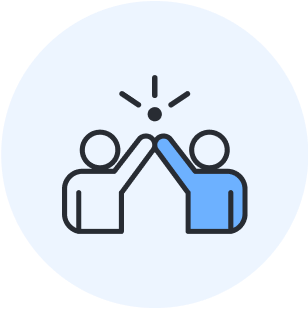
The ultimate Agile meetings toolkit for hybrid teams
Bryan Stallings
Reading time: about 13 min
20 years ago, teams first turned to Agile as a way to better collaborate, respond to change, and quickly deliver value. The Agile Alliance states that Agile essentially provided teams “a way of dealing with, and ultimately succeeding in, an uncertain and turbulent environment.”
Today’s challenges are increasingly more complex than those that existed when Agile first came to be. Constant, unpredictable change is now the norm in many industries and areas of the business world. The speed of technological change continues to accelerate, as does the pace of competition. Leading organizations are now deploying product upgrades hundreds of times a day. It takes exceptional teams, cross-organization collaboration, and program-level coordination to bring these solutions to life.
On top of all this change, teams are still adjusting to working in remote, distributed, or hybrid workplaces. Organizations are in a place where the ability to be agile—to succeed in a turbulent environment—is more important than ever. When teams are hybrid, though, they face a new set of challenges that makes it difficult to remain agile.
These challenges include:
- Disconnected workflows as teams juggle multiple tools.
- Delays and miscommunication resulting from asynchronous work.
- Difficulty fostering team trust, motivation, and buy-in.
- Balancing flexibility with accountability and team cohesion.
Looking at the Principles Behind the Agile Manifesto, it becomes clear how achieving what is intended with Agile can seem like a near-impossible task for hybrid teams. Many of these principles focus on communication, collaboration, and motivation—all of which suffer when teams aren’t in person together.
Take, for example, the sixth principle that asserts, “The most efficient and effective method of conveying information to and within a development team is face-to-face conversation,” or the fourth principle that states, “Business people and developers must work together daily throughout the project.”
We know these principles are necessary for agile teams to rapidly learn from each other, adjust appropriately, and continuously deliver value. This then begs the question: How can we reestablish agility to stay competitive when we’re working in different places, different times, and different ways?
Tips for remaining Agile in meetings with a hybrid team
It is indeed possible to continue Agile practices in a hybrid workplace. To demonstrate how, let’s take a look at some ways teams can make one of the most common Agile frameworks, Scrum, thrive in a hybrid setting. Keep these tips in mind throughout all of your Agile or Scrum meetings—or events, as they’re referred to in Scrum—to keep your hybrid team ahead of the curve:
Invest time up-front fostering team connections. In a hybrid environment, teams may lose some of the bonding that occurs naturally in an office setting, like water cooler talk or the playful conference room interactions that used to occur before meetings started.
Look for ways to connect your team members and encourage bonds outside of business, such as team lunches or one-on-one meetings between team members. When the barriers start to come down, empathy grows, trust forms naturally, and collaboration becomes more effective, and, with intentional effort, trust can be built.
Create a “safe to fail” culture, not a fail-safe one. Psychological safety is one of the most important foundational elements to an Agile team. For teams to truly embrace an Agile mindset, a culture that makes it okay to experiment, admit mistakes, and openly share ideas must exist.
Re-establish team norms and agreements. Team dynamics change drastically when members are working from various locations and at different times. It’s important to take time to establish processes and expectations for communication early on. You can think of this as slowing down now in order to speed up later. These could be as simple as coming to consensus on when to mute mics or have cameras on. Be sure to establish these agreements as a team to ensure all voices are heard and everyone is on board.
Brush up on your facilitation skills. With hybrid teams, it becomes even more important to have an effective facilitator to foster productive group collaboration, enable teams to develop a shared vision of the future, and decide on their direction forward. Keep our meeting facilitation toolkit handy for some best practices.
Use a visual, virtual “where” for agile team meetings to increase team collaboration. Hybrid teams still have each other (who), projects to work on (what), and times to meet and collaborate (when). What’s missing is the place to work, or the where—and we’ve noticed the absence. Teams that effectively fill this gap will be able to adapt and innovate much quicker than those teams that don’t address the gap.
Zoom and Slack are a good starting point for hybrid communication, but to really fill the gap teams need a place to collaborate, share ideas, and return to consistently. Look for a visual collaboration solution that enables hybrid teams to brainstorm, align, and co-create through virtual whiteboarding, real-time collaboration, and seamless integration with other tools. A solution like this inspires creative problem-solving, allows the best ideas to surface, and accelerates your team’s ability to learn, adapt, and deliver in a competitive market.

Why Agile teams need visual collaboration
Learn how visual collaboration helps Agile teams align, communicate, make decisions, and more.
Learn moreLucid’s tip: To help your hybrid team align, use team hubs in Lucid to create your team’s new home base. Now, your team can jump right into work with the processes, materials, and information needed to do their best work in one, centralized spot.
While the above tips can be applied throughout all your Agile meetings, each Scrum event has a slightly different goal, and therefore, a slightly different set of challenges that need to be addressed. To truly help your hybrid team stay competitive, here’s a series of tips and tools for each of the Scrum events, including a virtual Agile meeting space template in Lucidspark to kick-start your collaboration.

Sprint planning
Sprint planning kicks off a sprint by establishing the sprint goal, what can be done during the sprint, and how the chosen work will be completed. Developers, the product owner, and the Scrum master attend. During this event, it’s important for the entire team to agree on the sprint goal and their part in achieving it because they are jointly accountable for demonstrating the valuable outcomes achieved at the sprint review. The greater the depth of their agreement as a team, the more motivated they’ll be knowing the work will be inspected in the sprint review.
In a hybrid setting, coming to this consensus and ensuring that all team members are bought in on the goal is tricky. Don’t be concerned if sprint planning runs longer than in the past because coming to an agreement can sometimes take longer when teams are hybrid. Also, be aware that remote team members may face at-home distractions or feel left out of decisions unless the facilitator takes significant care.
Tips for facilitating sprint planning:
Be transparent. Visuals are so important for keeping everyone on the same page. Instead of taking notes individually, find a shared digital space where you and your team can collaborate on notes and document ideas and decisions together.
Make a decision—on how to make decisions. To ensure that every perspective is heard and the best ideas are surfaced during sprint planning, decide as a team on your process for making decisions. This could mean identifying a collaborative space where everyone can contribute ideas, using a practice like multi-voting to select among alternatives, or formalizing a team practice to call for a vote. In Lucid, you can use Visual Activities to capture the group’s input and make collaborative decisions.
Give it a try: Use this Lucidspark sprint planning template to guide you through your sprint planning meetings. Try team estimation to get the team’s input on the amount of effort associated with each task. When you’re ready to put your plan into action, convert sticky notes on your Lucid canvas into Jira or ADO integration cards (or import existing Jira issues and ADO items directly onto your Lucid canvas). With bi-directional syncing, any changes made in one platform will automatically reflect in the other.

Daily Scrum
The purpose of the daily Scrum, or daily standup, is to inspect progress toward the sprint goal and adapt the sprint backlog as necessary, adjusting the upcoming planned work. These quick events are for the developers and can take a variety of forms, with a common approach being to discuss progress made towards the sprint goal, identify roadblocks and individuals in need of help, and coordinate as a team on what each member plans to do next.
Ensuring everyone feels equally engaged in this meeting can be challenging when team members are attending this event from different locations. As teams adapt to frequent changes inherent in being hybrid, they should periodically reevaluate their practices for the daily Scrum to level the playing field for all team members and optimize this key Scrum event.
Tips for facilitating the daily Scrum:
Consider a remote-only approach for this meeting. When reviewing daily tasks and roadblocks, it’s often the in-person team members that speak first, with others contributing only at the end, as if an afterthought. To create a greater sense of team unity, consider a team agreement for all team members to attend this meeting virtually.
Test out different formats to find what works best for your team. Instead of each person running through their individual tasks, consider looking at a visual representing the work (like a Kanban board or product backlog) and discussing each of the backlog items by priority. This focuses the team on outcomes and keeps the entire team engaged, with team members contributing throughout.

Create a stellar daily stand-up template for your team with this quick course!
Register for the courseGive it a try: Use this daily standup template in Lucid to set up your daily Scrum meetings in the format that works best for your team. Add a data-backed progress bar to your canvas to easily visualize progress toward the sprint goal. By returning to the same Lucidspark board daily, you’ll create a one-stop shop for all notes and keep team members aligned on the sprint’s progress.

Sprint review
During the sprint review, the Scrum team demonstrates the outcome of the sprint to appropriate stakeholders, with the goal of gathering as much feedback as possible to adapt the product backlog. Sprint review and sprint planning are bookends on the sprint and are critical to establishing an inspect-and-adapt cadence.
In a hybrid environment, though, there are a few unique complications for sprint reviews that may make it more difficult to truly inspect the sprint outcome and gather feedback. With stakeholders joining from different locations, it may be difficult to encourage good practices. There is also a risk of this meeting turning into a demo and status update instead of a collaborative working session, drastically reducing the creative and productive feedback needed to improve.
Tips for facilitating the sprint review:
Communicate expectations upfront. Facilitators should help orient distributed participants by doing some pre-work before the review session. Take the time to create an agenda, establish precedents for interaction, and communicate these out ahead of time and at the beginning of the event.
Take advantage of visuals to inspire collaboration and engagement. To ensure you get as much participation and the best feedback possible, set up a shared virtual whiteboard where stakeholders can leave input and notes. Not only will this allow for a broader range of perspectives, but it will spur discussion and create a transparent record for reference both after the sprint review and during the next sprint planning.
To further foster a sense of trust between your team and stakeholders, be sure to follow up with the appropriate contributors on their ideas. By showing that you are listening and incorporating their feedback, the stakeholders will feel more connected to the outcome and will likely share thoughts in future sprint reviews.

Learn how to set up and implement a successful sprint review in Lucidspark!
Register for the courseGive it a try: The sprint review template from Lucid creates a sense of consistency and can be customized to summarize the sprint outcomes, collect and organize stakeholder feedback, and ensure follow-through. To encourage even more engagement, try holding voting sessions or using built-in Facilitator Tools such as the laser pointer. Gauge alignment at the end of the event using Visual Activities.

Sprint retrospective
During the sprint retrospective, the Scrum team inspects the sprint with regard to the individuals, communication, processes, and tools. While the sprint review is held with outside stakeholders and designed to elicit product feedback, the sprint retrospective is a team-only event designed to elicit feedback on the sprint itself. It’s a chance for the team to identify improvements to make the next sprint more effective and more enjoyable.
When teams are hybrid, though, they may not feel comfortable providing their input over video, especially if a sense of psychological safety has not been established. Hybrid environments also make it more likely for input to be misinterpreted, creating more tension or conflict.
Tips for sprint retrospectives:
Build intentional team connections. Until your team members have formed bonds with each other, it will be difficult for them to open up in retrospectives. Find ways to intentionally encourage this bonding, and remember that developing these connections takes time. Practice empathy and patience as the team grows and evolves over time.
Follow through on the team’s input. When a team member brings up an issue that can be resolved, take the time to actually do it. You’ll not only increase team productivity by removing an impediment, but you’ll also create a sense of trust that their voices are heard.

Learn how to host an effective sprint retrospective in Lucidspark with this short course.
Register for the courseGive it a try: Use the sprint retrospective template in Lucidspark to easily gather your team’s feedback in one collaborative workspace. Unlike other Scrum events that involve stakeholders, retrospectives are private conversations with the team, so keep this board private. If your team is still building psychological safety, turn on private mode to allow team members to share ideas, questions, and feedback anonymously.
To make the retrospectives interesting and encourage feedback and creative solutions, try switching up the retrospective format by dropping any of Lucidspark’s other retrospective templates, such as the 4-box or lean coffee retrospective, into your board.

These tips and templates provide a great framework for your Agile meetings, but keep in mind that all teams are different. It’s important to test, evaluate, and iterate your processes over time until you figure out what works best for your team. Once your team does establish a system for effective collaboration, you’ll be ideating, strategizing, and delivering solutions that not only meet customer needs—but exceed them.
Many enterprises are using the Lucid Visual Collaboration Suite to establish a system for effective collaboration and agility in today’s hybrid world. As the only visual collaboration solution to power every stage of work, Lucid helps 85% of users be more agile and iterate faster.
In fact, a study conducted by Forrester Consulting on behalf of Lucid found that teams who adopted Agile enabled by the Lucid Suite have saved 126,000 hours of overhead equating to a savings of $3.2 million (The Total Economic Impact™ Of The Lucid Visual Collaboration Suite, May 2023).
With the combination of Lucidspark, Lucidchart, and advanced automation and collaboration capabilities, you too can use the Lucid Suite to continuously adapt, innovate, and build the future.

Lucid makes Agile easy for hybrid teams—get in touch with us to learn more!
Try it nowAbout the author

As Chief Evangelist at Lucid Software and Certified Scrum Trainer, Bryan Stallings has coached thousands of individuals and teams in Agile and Scrum techniques.
About Lucid
Lucid Software is a pioneer and leader in visual collaboration dedicated to helping teams build the future. With its products—Lucidchart, Lucidspark, and Lucidscale—teams are supported from ideation to execution and are empowered to align around a shared vision, clarify complexity, and collaborate visually, no matter where they are. Lucid is proud to serve top businesses around the world, including customers such as Google, GE, and NBC Universal, and 99% of the Fortune 500. Lucid partners with industry leaders, including Google, Atlassian, and Microsoft. Since its founding, Lucid has received numerous awards for its products, business, and workplace culture. For more information, visit lucid.co.
Related articles
How to sustain the Agile Manifesto values in today’s workforce
Get expert tips on upholding each Agile Manifesto value in complex, hybrid working environments.
How Agile teams can prioritize “individuals and interactions” in a hybrid environment
Agile Manifesto co-authors and practitioners share how teams can prioritize individuals and interactions when hybrid.
All-access Agile: The comprehensive guide to daily standups
In this guide, we’re diving into what a daily standup meeting is and how to run one, plus sharing tips from Agile coaches.
